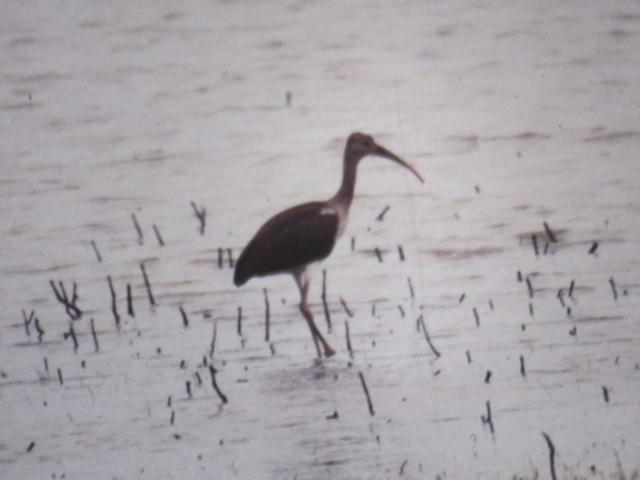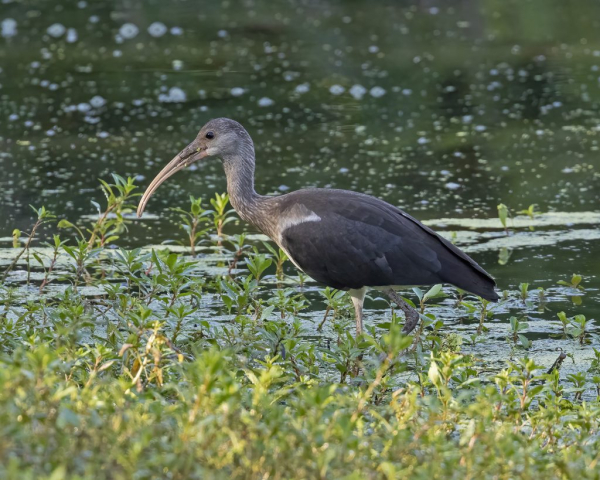Eudocimus albus albus
Status: Rare casual summer visitor central.
Documentation: Photograph: 5 Jul 1999 Kissinger Basin WPA, Clay Co.
Taxonomy: Two subspecies are recognized (AviList 2025), albus of the southeast United States and Caribbean, and ramobustorum of the Pacific Coast of South America and coastal northern Colombia and Venezuela.
Pyle (2025) synonymized ramobustorum with albus based on their not meeting the generally accepted 75% rule for subspecies diagnosability.
Subspecies ramobustorum was erected for South America populations formerly considered conspecific with E. ruber, Scarlet Ibis, prior to the split of the latter (Patten 2012; Gill et al 2022). The range of the southern subspecies of White Ibis (ramobustorum) overlaps that of Scarlet Ibis in Venezuela and Colombia. The status of white birds in the overlap zone is debated; it has been suggested they are a color morph of Scarlet Ibis ((Ramo and Busto 1987) but fewer than 10% of the birds in the large Scarlet Ibis colonies in Venezuela are white, and although hybridization occurs, mating appears to be assortative (Remsen et al 2011). We follow AviList (2025) in treating White Ibis and Scarlet Ibis as separate species, although genetic studies within the hybrid zone are needed.
Nebraska reports are presumed albus.
Summer: There are nine documented records:
10-11 Apr 2024 adult private site, Lancaster Co (NBR in press)
17 May 2000 adult Lake Ogallala, Keith Co (Brown and Brown 2001; Jorgensen 2002)
3-17 Aug 2022 immature Kirkpatrick Basin North WMA, York Co (Brogie 2023)
4-25 Jul 1999 immature Kissinger Basin WMA, Clay Co (Jorgensen 2001, 2004b)
9 Aug 2001 immature Funk WPA, Phelps Co (Jorgensen 2003, 2004b)
12-19 Aug 2001 immature Johnson WPA, Phelps Co (Jorgensen 2003, 2004b)
14-17 Aug 2022 Gretna, Sarpy Co (private site) (Brogie 2023)
19 Aug 2022 Jefferson Co (Brogie 2023)
25-28 Aug 2025 adult Cedar Vue, Lake McConaughy, Keith Co (Mlodinow, T. Brown, eBird.org).
The single first-year birds at Funk WPA 9 Aug 2001 and at Johnson WPA, Phelps Co, 12-19 Aug 2001 (Jeff Drahota, personal communication; Jorgensen 2003, 2004b) were possibly the same individual, as may have been the three 2022 birds. Jorgensen (2004a) noted that the Funk/Johnson bird was photographed at Johnson WPA 19 Aug 2001, not at Funk WPA.
Two additional reports are likely correct but lack extant documentation. One was observed 12-19 Jun 1916 at Inland Lagoon, Clay Co; the observer “was close enough to be sure” of the identification (Brooking, Notes), but no details were provided. This report was accepted by Jorgensen (2004b). Another was filmed by Karl Menzel during its stay in Rock Co 1-19 Aug 1963; although Paul Johnsgard viewed the film and confirmed Menzel’s identification of a juvenile (Menzel 1964), the film cannot now be located (Bray et al 1986).
White Ibises reaching Nebraska are probably post-breeding dispersers from southern United States populations; stragglers have reached southern Canada.
Images
Abbreviations
WMA: Wildlife Management Area (State)
WPA: Waterfowl Production Area (Federal)
Literature Cited
AviList Core Team, 2025. AviList: The Global Avian Checklist, v2025. https://doi.org/10.2173/avilist.v2025.
Bray, T.E., B.K. Padelford, and W.R. Silcock. 1986. The birds of Nebraska: A critically evaluated list. Published by the authors, Bellevue, Nebraska, USA.
Brogie, M.A. 2023. 2022 (34th) Report of the NOU Records Committee. NBR 91: 114-122.
Brooking, A.M. Notes. Bird specimen records. Manuscript in NOU Archives, University of Nebraska State Museum, Lincoln, Nebraska, USA.
Brown, C.R., and M.B. Brown. 2001. Birds of the Cedar Point Biological Station. Occasional Papers of the Cedar Point Biological Station, No. 1.
Gill, F., and D. Donsker (Eds). 2017. IOC World Bird List (v 7.3), accessed 30 January 2018.
Jorgensen, J.G. 2001. 1999 (Eleventh) Report of the NOU Records Committee. NBR 69: 85-91.
Jorgensen, J.G. 2002. 2002 (sic; =2000). (12th) Report of the NOU Records Committee. NBR 70: 84-90.
Jorgensen, J.G. 2003. 2001 (13th) Report of the NOU Records Committee. NBR 71: 97-102.
Jorgensen, J.G. 2004a. Correction to the 2001 (13th) Report of the NOU Records Committee. NBR 72: 65.
Jorgensen, J.G. 2004b. An overview of shorebird migration in the eastern Rainwater Basin, Nebraska. Nebraska Ornithologists’ Union Occasional Paper No. 8. Nebraska Ornithologists’ Union, Lincoln, Nebraska, USA.
Menzel, K.E. 1964. White Ibis in Rock County. NBR 32: 12-14.
Patten, M.A. 2012. The White Ibis Eudocimus albus subspecies of South America. Bulletin of the British Ornithologists’ Club 132: 128-132.
Pyle, P. 2025. A Practical Subspecies Taxonomy for North American Birds. North American Birds 76(1).
Ramo, C., and B. Busto. 1987. Hybridization between Scarlet Ibis (Eudocimus ruber) and the White Ibis (E. albus) in Venezuela. Colonial Waterbirds 10: 111-114.
Remsen, J.V., C.D. Cadena, A. Jaramillo, M. Nores, J.F. Pacheco, J. Pérez-Emán, M.B. Robbins, F.G. Stiles, D.F. Stotz, and K.J. Zimmer. 2011. A classification of the bird species of South America. www. museum.lsu.edu/~Remsen/ SACCBaseline.html.
Recommended Citation
Silcock, W.R., and J.G. Jorgensen. 2025. White Ibis (Eudocimus albus albus). In Birds of Nebraska — Online. www.BirdsofNebraska.org
Birds of Nebraska – Online
Updated 8 Sep 2025


